Scottish Aviation Twin Pioneer Video - Picture
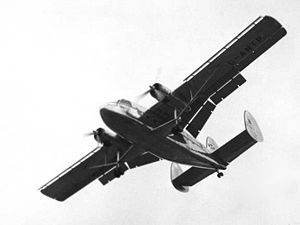
|
|
Scottish Aviation Twin Pioneer

Picture - Twin Pioneer prototype bearing Scottish Airlines markings at the 1955 Farnborough SBAC Show
Role: Transport
Manufacturer: Scottish Aviation
First flight: 25 June 1955
Introduced: 1956
Retired: 1968
Primary users: Royal Air Force
Malaysia
Nepal
Number built: 87
Developed from: Scottish Aviation Pioneer
The Scottish Aviation Twin Pioneer was a British STOL transport aircraft built by Scottish Aviation Limited at Prestwick Airport, Scotland, during the 1950s. It was designed with both civil and military operators in mind. It was conceived as a twin-engined version of the Pioneer light transport, either requiring "an area only 30m (99ft) by 275m (902ft) in which to operate."
Design and development
Powered by two Alvis Leonides 531 radial engines, the Twin Pioneer was a high-wing cabin monoplane with a triple fin and rudder assembly and fixed tailwheel undercarriage. The prototype Twin Pioneer, registered G-ANTP, first flew at Prestwick Airport on 25 June 1955. Flight trials proved that the aircraft had a very short landing run and the aircraft was displayed at the September 1955 Society of British Aircraft Constructors Show at Farnborough.
Three pre-production aircraft were built for trials, and sales and demonstrations.
In 1958, the 33rd aircraft was used as a prototype for the Series 2 with Pratt & Whitney Wasp R-1340 radial engines which had been ordered by Philippine Air Lines. A Series 3 aircraft was also developed to use the improved Alvis Leonides 531 radial engine.
Operational history
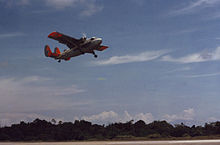
Picture - Scottish Aviation Twin Pioneer at Labuan
The military version could carry external stores such as bombs under the stub wings. One aircraft became the first aircraft for the newly formed Royal Malaysian Air Force. FM1062 c/n580 and FM c/n581 were delivered to the Malaysian Air Force 16 January 1962 and FM1064 c/n 583 FM1065 c/n 584 were delivered two days later. The first two aircraft were taken "on charge" by No 1 Squadron Royal Malaysian Air Force. The type served with the air force for 12 years. FM1064 c/n 583 is now on display at the Muzium Pengangkutan Melaka (Melacca Transport Museum) Malacca.
The Royal Air Force ordered 39 aircraft, which were built between 1958 and 1959, deployed in Aden and the Far East. It was used extensively by British forces in the Malayan Emergency and the later confrontation in Borneo. In August 1959, No. 78 Squadron RAF at Khormaksar received some Twin Pioneers to supplement its single engine Pioneers. The Twin Pioneers were employed in moving troops and supplies around the wilderness and on occasions, lending support to the Sultan of Oman. A series of double engine failures caused problems with the squadron losing two aircraft on the same day. Unsuitable soft and hard landing strips were also causes of failures during landings.
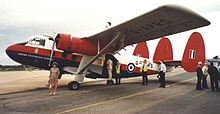
Picture - Twin Pioneer of Air Atlantique at Exeter in 1998
Other squadrons that operated the Twin Pioneers were No. 152 Squadron RAF based at Muharraq in Bahrain: No. 21 Squadron RAF, which reformed with the type at Benson in May 1959. The squadron then moved to Kenya and in June 1965 to Aden. No. 152 operated around the Persian Gulf and in 1959, No. 209 Squadron RAF based at Seletar began to receive Twin Pioneers. These operated in Borneo and Malaya. The SRCU (Short Range Conversion Unit) at RAF Odiham also flew three Twin Pioneers for aircrew training. RAF No. 230 Squadron in the UK was the last military operator of the Twin Pioneer. The squadron operated the type in an interesting sand-colour camouflage scheme.
Although mainly used in military operations, the Twin Pioneer was also successful as a commercial transport for operation in areas without proper airfields, where unprepared surfaces were often the norm. Twin Pioneers were sold as survey aircraft to oil exploration companies with some of the first sales to Rio Tinto Finance and Exploration Limited, and the Austrian and Swiss government survey departments. Three were used by the 'Kroonduif' in Dutch New Guinea.
One Twin Pioneer served as a STOL training aircraft with the Empire Test Pilot School (ETPS) at RAE Farnborough for many years. In 2009, Air Atlantique of Coventry currently operates it on public flights in civil markings, retaining its ETPS colour scheme.
Variants
Twin Pioneer : Prototype aircraft with Alvis Leonides 503 radial engines, one built.
Twin Pioneer Series 1 : Production aircraft with Alvis Leonides 514 radial engines.
Twin Pioneer CC.Mk 1 : Military version of the Series 1 for the Royal Air Force, 32 built.
Twin Pioneer CC.Mk 2 : Military version of the Series 1 for the Royal Air Force, 7 built.
Twin Pioneer Series 2 : Production aircraft with Pratt & Whitney R-1340 radial engines.
Twin Pioneer Series 3 : Production aircraft with Alvis Leonides 531 radial engines.
Operators
Civil operators
Australia
Picture - Scottish Aviation Twin Pioneer Srs3, VH-AIS
Austria
Canada
Dutch New Guinea
Ecuador
Iceland
Indonesia
Iran
Kuwait
Laos
Malaysia
Mexico
Nepal
Nigeria
North Borneo
Norway
Philippines
Sierra Leone
Switzerland
United Kingdom
United States
Military operators
Malaysia
Royal Malaysian Air Force
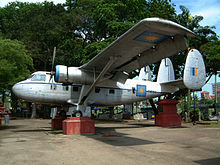
Picture - Scottish Aviation Twin Pioneer FM1061 c/n 578 of the Royal Malaysian Air Force
Nepal United Kingdom
Royal Air Force
No. 21 Squadron RAF
No. 78 Squadron RAF
No. 152 Squadron RAF
No. 209 Squadron RAF
No. 225 Squadron RAF
No. 230 Squadron RAF
Empire Test Pilots' School
Incidents and accidents
A recorded loss of a Twin Pioneer occurred on take off from Limbang Airport on 17 May 1967. The aircraft, operated by Malaysia-Singapore Airlines, carried the registration 9M-ANC. The cause was given as 'unknown.
Specifications (Twin Pioneer CC.Mk 2)
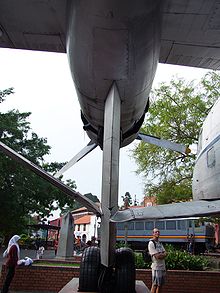
Picture - Fixed undercarriage of Twin Pioneer CC.Mk 1
Data from Green.
General characteristics
Crew: Two (pilot and co-pilot)
Capacity: Up to 13 troops or 2,000 lb (907 kg) of cargo
Length: 45 ft 3 in (13.79 m)
Wingspan: 76 ft 6 in (23.32 m)
Height: 12 ft 3 in (3.73 m)
Wing area: 670 ft² (62 m²)
Empty weight: 10,062 lb (4,564 kg)
Loaded weight: 14,600 lb (6,622 kg)
Max takeoff weight: 14,600 lb (6,622 kg)
Powerplant: 2x— Alvis Leonides 531 radial engine, 640 hp (564 kW) each
Performance
Maximum speed: 143 knots (165 mph, 266 km/h)
Range: 695 nm (791 mi, 1,287 km)
Service ceiling: 20,000 ft (6,098 m)
Rate of climb: 1,250 ft/min (381 m/min)
Related development
Scottish Aviation Pioneer
Comparable aircraft
Percival Pembroke
Bibliography
Green, William. Macdonald Aircraft Handbook. London. Macdonald & Co. (Publishers) Ltd., 1964.
Donald, David, ed. The Encyclopedia of World Aircraft. London: Aerospace Publishing, 1997. ISBN 1-85605-375-X.
Thetford, Owen. Aircraft of the Royal Air Force 1918-57, 1st edition. London: Putnam, 1957.
Scottish Aviation Twin Pioneer Pictures
More airplane videos.
Source: WikiPedia